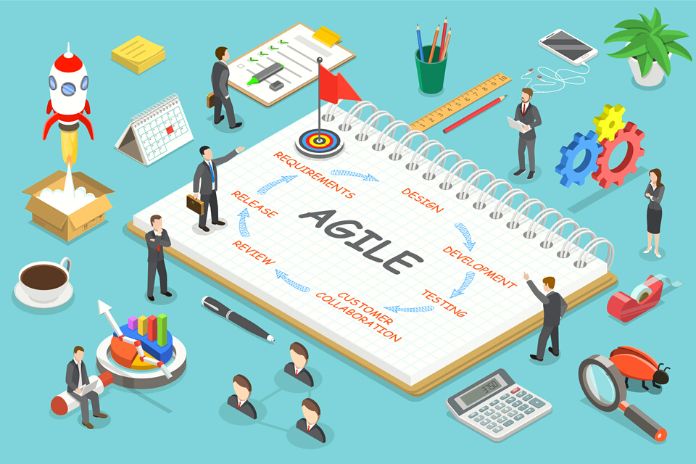‘ Agile project management ‘ is an umbrella term for creating techniques that adopt a gradual and iterative strategy. While it started in programming advancement and is as yet found fundamentally in this climate, its standards can be applied to different disciplines.
Throughout the long term, different systems for Deft Venture The board have spread, like Scrum, AgilePM®, PRINCE2® Light-footed, and the Praxis Structure. Nonetheless, the various subtleties in the utilization of Spry are joined by a few central qualities, detailed in the Deft Pronouncement :
- Short cycles of improvement are known as runs.
- I work intimately with designers and partners.
- A normal reprioritization of work.
- Quick and adaptable way to deal with tending to scope changes.
Different strategies have advanced to help these highlights, for example, timeboxes for planning, the Moscow technique for prioritization, and torch outlines for providing details regarding progress. A straightforward method for understanding the distinction between Lithe and more conventional types of improvement is to recognize their relationship with the triple imperative (scope, time, cost), as outlined in the figure beneath.
In conventional plans, the accentuation is on the extension. In Spry undertakings, the attention is on time and cost. Content is gotten from these, so arranging figures out which content can be considered inside time and cost imperatives.
Scrum
Scrum is a popular development process for Agile Project Management. It was created by Jeff Sutherland in 1993 using an analogy to the sport of Rugby to represent a highly integrated and cross-functional team. To get more details about Scrum, you can read this post.
AgilePM®
AgilePM® is a complete “package” that includes a Project Management methodology and a methodology for creating and releasing products. It contains everything you need to manage and implement projects in an agile way and is easy to understand and implement.
AgilePM® was created by the non-profit Agile Business Consortium (formerly known as the DSDM Consortium) and is the result of 20 years of experience and continuous feedback from projects from the public and private sectors. Several agile approaches based on iterative product development effectively achieve this goal. AgilePM® believes that the characteristics of projects differ from those of product iterative development.
The method considers that projects have a life cycle and that their strategic alignment and related business case must be investigated to understand the benefits and the value that the project results will allow to obtain. The philosophy of the Agile Business Consortium states that each project must be aligned with or clearly defined strategic objectives and must focus on rapidly delivering concrete benefits to the business.
The critical word here is “quickly.” An agile approach must enable benefits to be reaped faster than a traditional project management approach. The AgilePM® lifecycle allows you to achieve this goal during the Pre-project, Feasibility, and Foundations phases. AgilePM® has a well-defined life cycle, allowing you to keep the project under control from conception until the benefits are obtained.
How does AgilePM® work?
The project is divided into short, well-focused periods with clearly specified objectives. The work is divided into timeboxes with fixed deadlines, during which development occurs in evolutionary mode. Using MoSCoW prioritization ensures that deliverables are constantly re-evaluated in light of business priorities.
The roles that must be covered in the Project Management and Delivery teams are clearly defined and have specific responsibilities; all Business, Project Management, and Technical Development roles required to manage, implement and deliver project deliverables are represented. To obtain the best results from the application of AgilePM®, it is suggested to request the support of a Coach.
Eight principles should be applied throughout the project: Also indicated are five critical success factors that need to be monitored to ensure that the spirit of AgilePM® is kept alive throughout the project:
- Embrace the AgilePM approach
- An effective team to develop solutions
- Business engagement
- Iterative development, integrated testing, and incremental releases
- Transparency
The Agile Business Consortium has also made available a Project Approach Questionnaire to evaluate the applicability of the AgilePM approach to a specific project. The AgilePM® guide also indicates how to behave in environments where the benefits of the Agile approach are not perceived.
Who Could Use AgilePM®?
The AgilePM® approach can be applied by all organizations wishing to adopt an Agile approach, whether they are already adopting a structured Project Management approach or the opposite. The method can be integrated easily with PRINCE2® since the roles defined in the two systems are complementary, and the life cycles are similar; AgilePM® has more, compared to PRINCE2®, the functions necessary for the realization of the requirements.
AgilePM® can also be applied to any existing Agile development methods, such as Scrum, since Agile development methods are a bit similar. Compared to Scrum, it adds the roles necessary to direct and manage the project.
Certifications Available
Two different levels of certification are available for this guide:
- Level 1 – AgilePM® Foundation. This level of accreditation demonstrates that the practitioner knows and understands all elements of the methodology.
- Level 2 – AgilePM® Practitioner: this level of certification demonstrates that the practitioner can apply the elements of the methodology to a case study.
Prince2 Agile®
This is a new guide to Agile Project Management, written by Keith Richards, the same author of the AgilePM® guide. PRINCE2 Agile® is particularly useful for those who apply Scrum and want to achieve better project governance or those who use PRINCE2® and wish to understand how to integrate this method with Agile frameworks for product development.
Certifications Available
For this guide, different levels of certification are available:
- PRINCE2 Agile® Foundation; this level of certification demonstrates that the practitioner knows and understands all elements of the methodology.
- PRINCE2® Agile® Practitioner: this level of certification demonstrates that the practitioner can apply the elements of the methodology to a case study.

